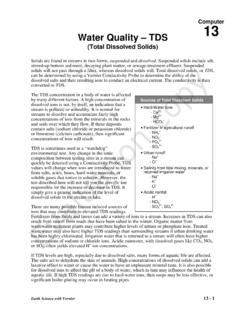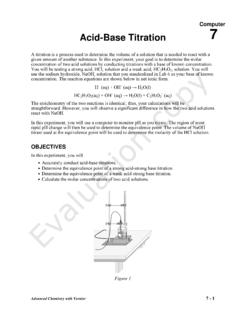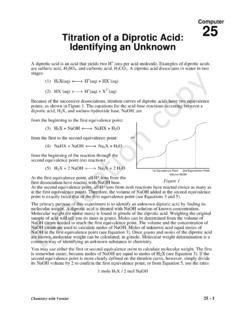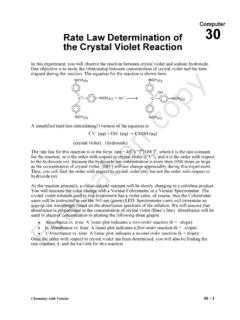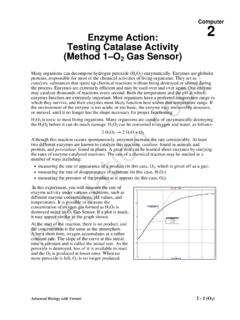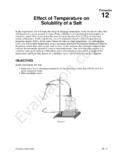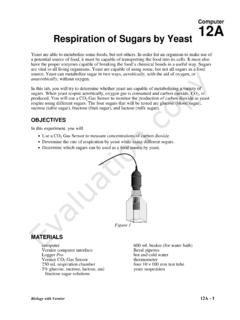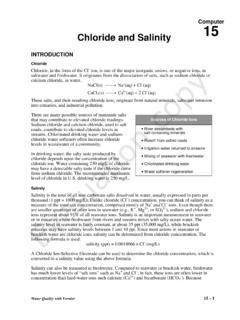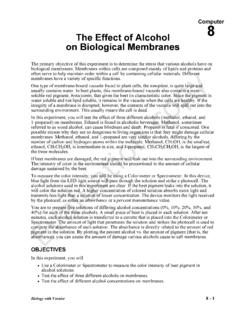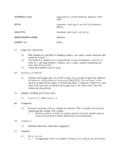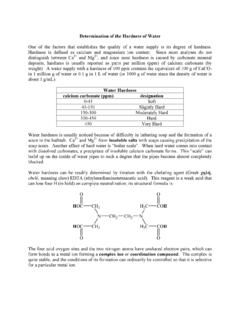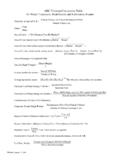Transcription of Test 14 Total Hardness - Vernier Software & …
1 Computer 14 Water Quality with Vernier 14 - 1 Total Water Hardness INTRODUCTION When water passes through or over deposits such as limestone, the levels of Ca2+, Mg2+, and HCO3 ions present in the water can greatly increase and cause the water to be classified as hard water. This term results from the fact that calcium and magnesium ions in water combine with soap molecules, making it hard to get suds. In Test 13, Calcium and Water Hardness , an Ion-Selective Electrode was used to determine calcium Hardness , in mg/L as CaCO3.
2 In this test, Total Hardness will be determined. Total Hardness is defined as the sum of calcium and magnesium hardness1, in mg/L as CaCO3. In addition to Total Hardness , the test described here will allow you to determine the concentration of Mg2+, in mg/L. High levels of hard-water ions such as Ca2+ and Mg2+ can cause scaly deposits in plumbing, appliances, and boilers. These two ions also combine chemically with soap molecules, resulting in decreased cleansing action. The American Water Works Association indicates that ideal quality water should not contain more than 80 mg/L of Total Hardness as CaCO3. High levels of Total Hardness are not considered a health concern. On the contrary, calcium is an important component of cell walls of aquatic plants, and of the bones or shells of aquatic organisms. Magnesium is an essential nutrient for plants, and is a component of chlorophyll.
3 Expected Levels Total Hardness in freshwater is usually in the range of 15 to 375 mg/L as CaCO3. Calcium Hardness in freshwater is in the range of 10 to 250 mg/L, often double that of magnesium Hardness (5 to 125 mg/L). Typical seawater has calcium Hardness of 1000 mg/L, magnesium Hardness of 5630 mg/L, and Total Hardness of 6630 mg/L as CaCO3. <120 mg/L120 - 180 mg/L>180 mg/L Total water Hardness , in mg/L as CaCO3 1 Even though Fe2+, Fe3+, Sr2+, Zn2+, and Mn2+ may contribute to water Hardness , their levels are typically much less than Ca2+ and Mg2+. Their levels are not usually included in Total Hardness measurements. Hard-Water Cations Calcium, Ca2+ Magnesium, Mg2+ Others: Fe3+, Sr2+, Zn2+, Mn2+ Total Hardness (mg/L as CaCO3) Soft: 0-30 Moderately soft: 30-60 Moderately hard: 60-120 Hard: 120-180 Very hard: > 180 Evaluation copy Computer 14 14 - 2 Water Quality with Vernier Table 1.
4 Ca Hardness , Mg Hardness , and Total Hardness in Selected Sites Site (fall season) Ca Hardness (mg/L as CaCO3) Mg Hardness (mg/L as CaCO3) Total Hardness (mg/L as CaCO3) Merrimack River, Lowell, NH Mississippi River, Memphis, TN Rio Grande River, El Paso, TX Ohio River, Grand Chain, OH Willamette River, Portland, OR Missouri River, Garrison Dam, ND Sacramento River, Keswick, CA Hudson River, Poughkeepsie, NY Platte River, Louisville, NE Colorado River, Andrade, CA Summary of Method The sample is first adjusted to a pH of 10 using a buffer solution. The sample is titrated to its equivalence point using a standard EDTA EDTA draws the calcium and magnesium ions into a complex, so neither one has free ions in solution.
5 The Calmagite indicator initially turns red in the presence of magnesium, then turns blue when enough EDTA solution has been added to combine with all calcium and magnesium ions The Total Hardness of the sample is calculated using the precise volume of EDTA solution added when the indicator changes color, as well as the EDTA concentration, in mol/L. If calcium concentration was determined in Test 13, magnesium concentration can also be calculated (in mg/L Mg2+) Here is a summary of the measurements and calculations in Test 14. Sample values are included. a. Total Hardness as CaCO3, obtained using the EDTA titration = 120 mg/L (sample value) b. Mg Hardness as CaCO3 = Total Hardness calcium Hardness (Test 13) = 120 70 = 50 mg/L c. Mg2+ = (50 mg/L as CaCO3) (24 g Mg2+ / 100 g CaCO3) = 12 mg/L as Mg2+ 2 EDTA is an abbreviation for ethylenediaminetetraacetic acid.
6 Total Water Hardness Water Quality with Vernier 14 - 3 Total WATER Hardness Materials Checklist ___ sampling bottles ___ Hardness 1 Buffer Solution ___ 100 mL graduated cylinder ___ two Calmagite3 indicator powder pillows ___ 250 mL Erlenmeyer flask ___ M EDTA4 titrant (TitraVer Standard Solution) ___ 25 or 50 mL buret ___ water bottle with distilled water Collection and Storage of Samples 1. This test must be conducted in the lab. Collect at least 300 mL of sample water. 2. It is important to obtain the water sample from below the surface of the water and as far away from the shore as is safe. If suitable areas of the stream appear to be unreachable, samplers consisting of a rod and container can be constructed for collection. Refer to page Intro-4 of the Introduction for more details. Testing Procedure 1.
7 Obtain a clean buret and rinse it with a few mL of the M EDTA titrant (TitraVer Standard Solution). Fill the buret a little above the 0 mL level with the EDTA solution. Drain a small amount of the solution so it fills the buret tip and leaves the EDTA solution at the 0 mL mark (or just below it). Record the buret level on the Data & Calculations sheet, to the nearest mL. 2. Prepare the water sample for titration. a. Use a graduated cylinder to measure 50 mL of your water sample into a 250 mL Erlenmeyer flask. b. Add 1 mL of Hardness 1 Buffer Solution to the Erlenmeyer flask using the 1 mL calibrated dropper. Gently swirl the contents of the flask to mix. c. Add the contents of one Calmagite3 powder pillow to the Erlenmeyer flask. Gently swirl the contents of the flask to mix. The solution should now be red in color.
8 3. Titrate the sample you prepared in Step 2. a. Slowly add M EDTA titrant to the sample in the Erlenmeyer flask start with 1 mL additions. Swirl the sample after each addition of titrant. b. Near the equivalence point, the red color will start to fade, and become more violet (mixture of red and blue). You should reduce the addition volume to 1 drop at a time. Note: The reaction at the equivalence point is very slow (~1 second), so take your time. c. When the last tinge of red starts to disappear and turn to a pure blue color, you have reached the equivalence point. Record the final buret volume (to the nearest mL) on your Data & Calculations sheet. 3 Calmagite is contained in ManVer 2 Hardness Indicator Powder Pillows. 4 Hach TitraVer Hardness Titrant is labeled as M EDTA, and also as an equivalent concentration of N.
9 Computer 14 14 - 4 Water Quality with Vernier d. If you are unsure whether you have reached the equivalence point, simply record the buret volume, then add another drop of EDTA titrant. If the color becomes a truer blue color, use the new buret reading; if not, use the previous buret reading. 4. Perform a second titration trial. To do this, discard the first titration mixture, as directed by your instructor. If you have enough titrant left for a second titration, simply record the current buret level; if not, refill the buret and record the buret level.
10 Rinse the 250 L Erlenmeyer flask twice with distilled water, then repeat Steps 2 3. Calculations 1. To determine the titrant volumes used, subtract the initial volume from the final volume for each trial. Record the titrant volumes for the two trials on the Data & Calculations sheet. Important: If the titrant volumes for the two trials are not in close agreement, you should repeat Steps 1 3 of the Testing Procedure until you have two trials that are close. 2. Calculate the value for Total water Hardness . a. For each trial, determine Total water Hardness using the equation Total water Hardness as CaCO3 (mg/L) = (titrant volume) b. Record the Total water Hardness value on the Data & Calculations sheet. Optional Calculations 3. Calculate magnesium Hardness (mg/L as CaCO3) and magnesium concentration (mg/L Mg2+).

